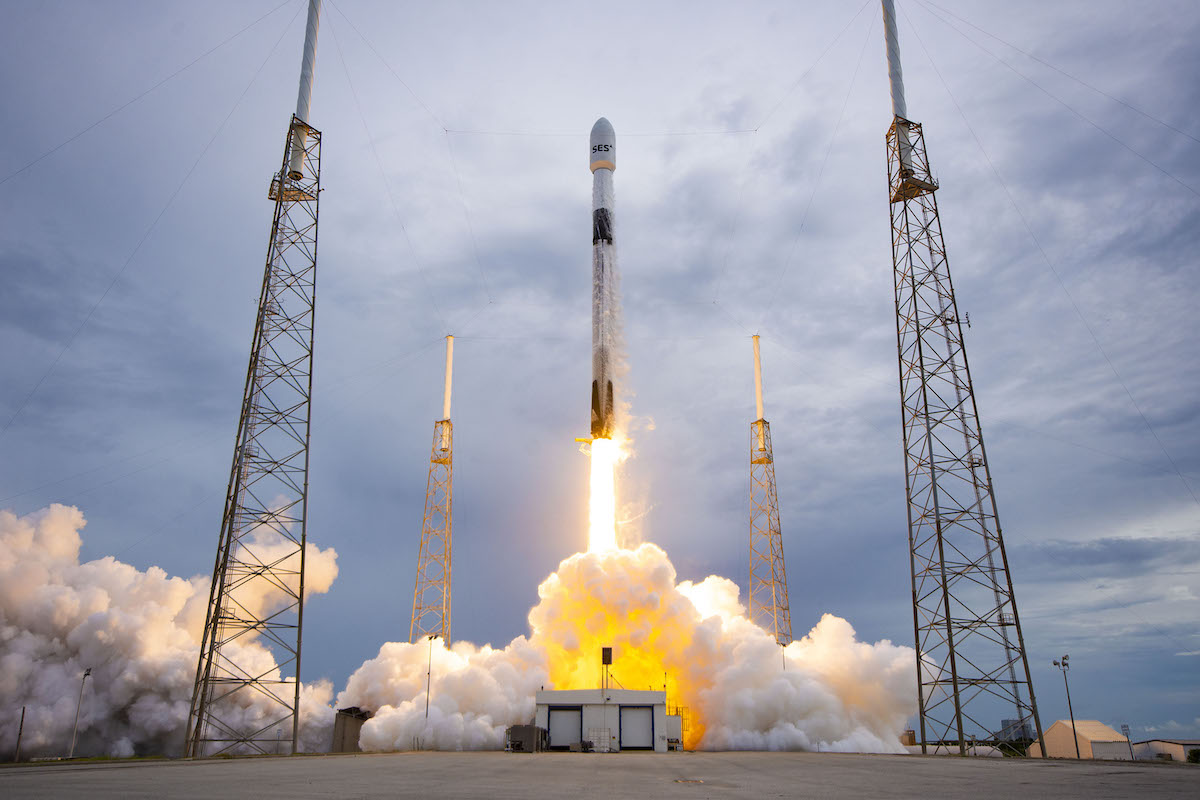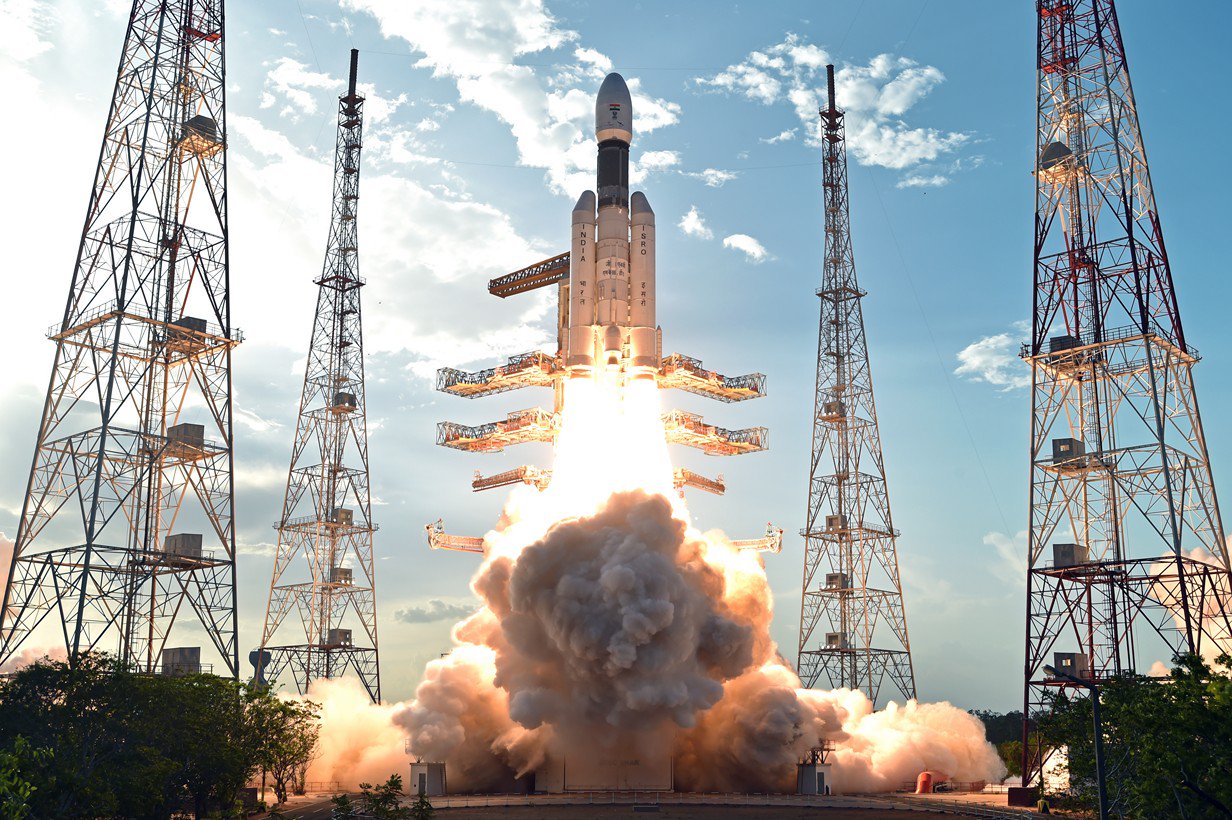
OneWeb and Eutelsat announced plans to merge Tuesday, bringing together OneWeb’s network of internet satellites in low Earth orbit with Eutelsat’s fleet of larger video, data relay, and broadband platforms in geostationary orbit.
OneWeb’s chairman also said Tuesday the company is on track to resume deploying its remaining internet satellites as soon as September, with three SpaceX flights and two Indian launches on tap to replace Russian Soyuz rockets no longer available after Russia’s invasion of Ukraine.
The merger of OneWeb and Eutelsat is a major consolidation in the commercial satellite communications market.
Founded in 2012, OneWeb is a relatively new player in the segment, and has launched 428 of its planned 648 first-generation internet satellites into low Earth orbit, or LEO, at an altitude of around 745 miles (1,200 kilometers). OneWeb operates one of the two large satellite “mega-constellations” currently active in low Earth orbit, alongside the even larger fleet of SpaceX’s Starlink internet satellites, which now numbers around 2,700 spacecraft in orbit, either in service or maneuvering toward their operational altitudes.
OneWeb weathered bankruptcy in 2020, and emerged under the majority ownership of Bharti Global, an Indian telecom company, and the UK government.
Eutelsat, which already holds a 23% stake in OneWeb, was established in 1977 as a European intergovernmental organization, and became a commercial company in 2001. Eutelsat has a fleet of 36 spacecraft flying in geostationary orbit, or GEO, more than 22,000 miles (nearly 36,000 kilometers) over the equator. GEO satellites are typically bigger and more powerful than LEO broadband satellites, providing services to more customers over a fixed geographic region. But they come with coverage limitations over the poles, and their connections come with higher latency, or lag, than LEO constellations.
OneWeb’s business is focused on providing high-speed, low-latency internet services to customers around the world, connecting homes, businesses, schools, airplanes, and ships. Eutelsat’s satellites are primarily focused on traditional video and data services, with some overlap with OneWeb in the internet market.
The merger is one between equals, OneWeb and Eutelsat officials said, with shareholders in each enterprise holding 50% of the combined company once the transaction closes, which is expected by the end of the first half of 2023. The boards of directors of both companies unanimously approved the memorandum of understanding announced Tuesday, but the deal still must pass regulatory approval and win the support of shareholders.
Eutelsat and OneWeb will continue operating under their current names, with Eutelsat remaining headquartered in Paris and OneWeb in London. The agreement sets a valuation of $3.4 billion for OneWeb.
The companies said their operations are “highly complementary” and the merger presents opportunities to develop a common platform for their LEO and GEO services, with hybrid user terminals and interconnected network creating a “one-stop shop” for customers.
“This is truly a first in our industry,” said Dominique D’Hinnin, chairman of Eutelsat. “We will be the only integrated GEO/LEO player around the world.”
“The compelling economics and high throughput of GEO, combined with low latency and ubiquity of LEO constellations, will meet a much wider range of customer requirements,” said Eva Berneke, CEO of Eutelsat, in a teleconference with reporters.

SES, another large operator of geostationary communications satellites, has shunned developing its own LEO broadband constellation in favor of a fleet of internet satellites in Medium Earth Orbit about 5,000 miles (8,000 kilometers) above Earth. According to SES, the O3b constellation in MEO combines the high-throughput benefit of geostationary satellites with the lower latency offered by lower-altitude satellites.
While OneWeb still has about 220 satellites to launch before completing its first-generation network, the company is already planning an even larger constellation called Gen 2. OneWeb announced an agreement with Relativity Space last month for multiple Gen 2 satellite launches beginning as soon as 2025 on the launch company’s next-generation reusable Terran R rocket.
Eutelsat’s resources will now help OneWeb finance its Gen 2 constellation. OneWeb’s other current shareholders include Bharti, the UK government, and the Japanese company Softbank, among others.
“Having made a $500 million investment in OneWeb two years ago, the UK government will now have a significant stake in what will become a single, powerful, global space company, working on the sound financial footing needed to make the most of the technological advantages it has to compete in the highly-competitive global satellite industry, against companies around the world,” said the UK’s Department for Business, Energy, and Industrial Strategy.
The UK government said it will retain its “special share” and “exclusive rights” over OneWeb in areas such as national security usage of the network and “first-preference” rights for industrial opportunities.
The UK government will retain the special share and its exclusive rights over OneWeb – securing the company’s future at the centre of the combined group’s global LEO business, national security co over the network, and first-preference rights over domestic industrial opportunities.
Sunil Bharti Mittal, OneWeb’s executive chairman, said the company will give preference to a UK location for the factory for its Gen 2 broadband satellites. The first-generation OneWeb satellites are built in a factory near the Kennedy Space Center in Florida through a joint venture with Airbus.
Mittal said most of the 220 remaining satellites to complete the first-generation network have completed manufacturing Florida. The Florida factory can now be used to produce satellites for other customers.

OneWeb launched its first 428 satellites on 13 Russian-made Soyuz rockets from February 2019 through February of the year. The Soyuz missions were booked through Arianespace, the French launch service provider with rights to market and manage commercial Soyuz launches.
Arianespace was on the hook with OneWeb for six more Soyuz launches from the Baikonur Cosmodrome in Kazakhstan, including a 14th launch that was set to take off in March. But Russia’s space agency set conditions on the mission after rolling the rocket and the OneWeb satellites to a launch pad at Baikonur, including a demand that the UK government give up its stake in OneWeb.
The UK government declined, and OneWeb announced March 3 it was suspending launches from Baikonur. Less than a month later, OneWeb announced an agreement with SpaceX to launch some of its remaining satellites. OneWeb finalized a similar agreement with New Space India Limited, the commercial arm of India’s space agency, for launches on Indian rockets.
The contract with SpaceX was surprising to many satellite industry watchers because OneWeb is an indirect competitor in broadband market. SpaceX sells Starlink service directly to consumers, while OneWeb sells to enterprises and internet service providers to provide connectivity for entire businesses or communities.
Mittal said OneWeb was “very fortunate” to recover from the launch setback earlier this year, with plans to resume launches later this year. There are three Falcon 9 flights planned for OneWeb into polar orbit from Cape Canaveral — a short drive from OneWeb’s factory — in late 2022 and early 2023. OneWeb has procured two launches on India’s GSLV Mk.3 rocket.
The three Falcon 9 flights will be equivalent o the launch capacity of four Soyuz rockets, which carried as many as 36 OneWeb satellites on each flight. That would mean SpaceX will launch around 48 OneWeb spacecraft on each mission, although the exact figures haven’t been confirmed.
The five additional launches should be complete by next March, with all the satellites entering commercial service by the end of 2023, Mittal said.
Email the author.
Follow Stephen Clark on Twitter: @StephenClark1.
from Spaceflight Now https://ift.tt/t7GMBSg
via World Space Info







0 comments:
Post a Comment